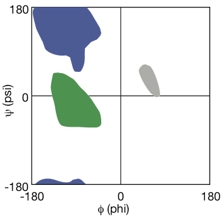So now that we've talked about alpha helix and beta sheet secondary structures, in this video, we're going to talk about another type of secondary structure: the beta turns and loops. Beta turns and loops are a type of non-repetitive secondary structure. By non-repetitive, all we mean is that they don't have that same repetitive periodic structure that alpha helices and beta sheets have. However, beta turns and loops do cause the peptide backbone to change directions. These structures are usually found on the surface of proteins with hydrophilic amino acid residues. Being on the surface of proteins allows the hydrophilic amino acid residues to easily interact with their aqueous environment in which most proteins are situated. Moreover, beta turns and loops enable the proteins to take on a folded, compact shape. You can imagine a protein that has a folded compact shape must change the backbone direction frequently. Otherwise, it would continue in one direction and would not have a compact shape. Thankfully, beta turns and loops that allow for changes in backbone direction enable us to have proteins with folded compact shapes.
Now, we are going to distinguish between the loops and beta turns. Loops are essentially large links of amino acids that cause changes in backbone direction without fixed internal hydrogen bonds; they do not utilize fixed internal hydrogen bonds. Beta turns, on the other hand, also known as reverse turns, are small loops that have less than four amino acid residues and cause abrupt changes in backbone direction. They are able to do this because they are stabilized by fixed internal hydrogen bonds unlike the loops.
In our example below, we will identify all the loops and beta turns in the figures. Notice in our first figure over here on the left, we have a single polypeptide chain with an N-terminal and a C-terminal. You'll see we have beta sheets, alpha helices, and more beta sheets, or beta strands. Notice that this beta strand is connected to this alpha helix here via a loop. We know that it's a loop because it contains 20 amino acids, which is greater than four amino acids. This is a large link of amino acids causing a change in the backbone direction. Observe how the backbone direction changes through this loop.
In our next example, notice what we have is a beta turn, and we know this is a beta turn because the backbone is abruptly changing directions, doing a quick U-turn. It incorporates a small link of amino acids, less than four amino acids, and it's stabilized by this internal hydrogen bond. That's a way to identify it as a beta turn. Notice in this image that with the loop, there are no internal hydrogen bonds.
In the image on the far right, we have a single polypeptide chain that exhibits several secondary structures. It has the yellow structures, which are beta sheets, the pink structures, which are alpha helices, and it includes beta turns and loops. The grayish links of long amino acids are the loops, causing changes in the backbone direction. The shorter blue structures throughout are our beta sheets and are labeled as beta turns because they cause abrupt changes in the backbone direction with a small amount of amino acid residues. Moving forward, we'll be able to practice more with beta turns and discuss different types of beta turns that exist.
I'll see you guys in those videos.



